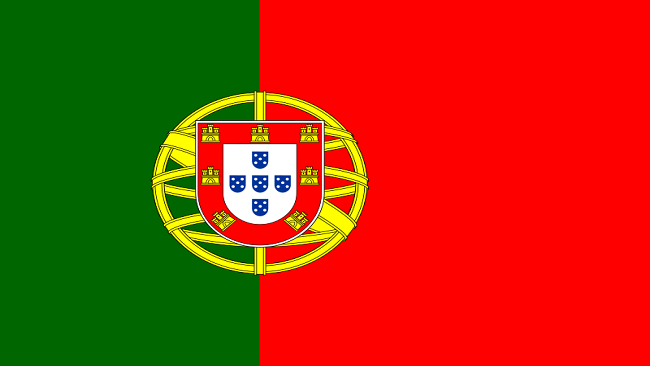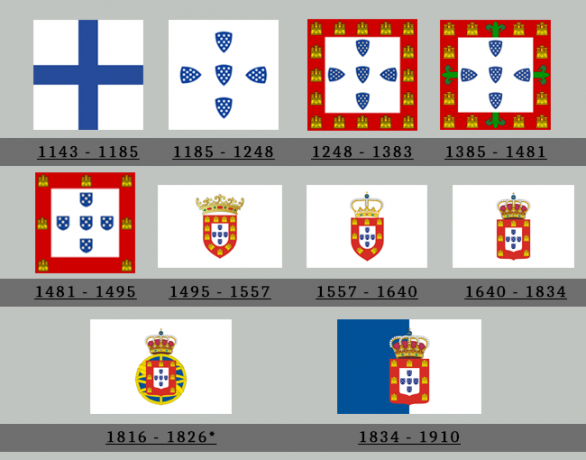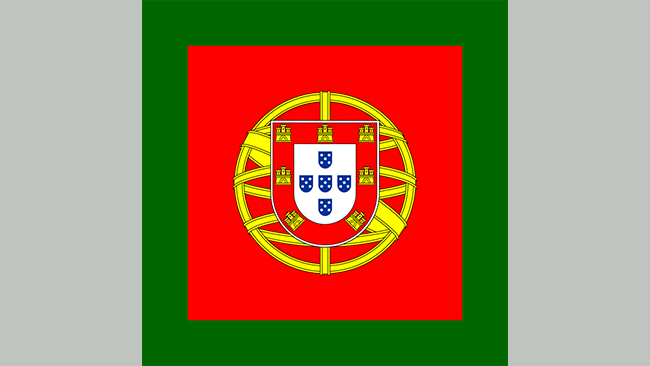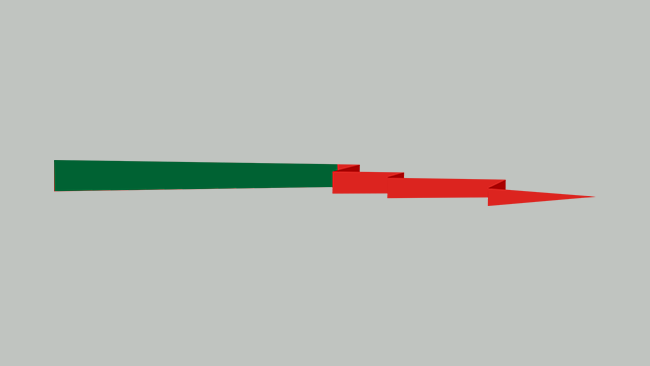The flag of Portugal is one of the national symbols of the Portuguese Republic. The flag is rectangular in shape and is vertically split unevenly, with the right side larger than the left side.
The left side of the flag of Portugal is colored green and the right side is colored red. Above the dividing line is the coat of arms formed by the Portuguese shield and the armillary sphere.
The flag of Portugal was drawn up by a commission appointed by the government on October 15, 1910. The commission was formed by the painter Bordalo Pinheiro, the journalist João Chagas and the writer Abel Botelho. The project was approved on November 29 of the same year.
The flag of Portugal is also called Bandeira das Quinas and Bandeira Verde-Rubra.
Portugal Flag Elements and Meanings

The flag of Portugal is composed of green and red, the armillary sphere and the Portuguese shield.
Portugal Flag Colors
On the flag of Portugal, the green color means the hope of the Portuguese people and the red color means the blood of those who died in battle.
Armillary sphere

The armillary sphere is an astronomical tool that consists of a spherical representation of the universe. The instrument works as a kind of compass that adopts the sun and stars as a reference point, and was widely used in navigation.
The armillary sphere became an important object in the period of the Great Navigations (15th to 17th century) and became a symbol of the Portuguese discoveries at the time.
In the elaboration of the flag, the responsible commission described the armillary sphere as an eternal symbol of the Portuguese adventurous genius.
Portuguese shield

It is considered the main symbol of Portugal. The Portuguese shield has been present on national flags since 1143. Currently the symbol contains seven yellow castles and five blue shields each containing five besants (gold coins in the Byzantine Empire). The meaning of these symbols is controversial.
Some believe that the shields are related to the so-called "Miracle of Ourique", according to which Jesus would have appeared to Count Afonso Henriques and prophesied his victories at the Battle of Ourique over five kings Moors. Thus, the shields would have been placed on the cross-shaped flag in honor of Jesus Christ.
The seven castles symbolize the supposed seven fortresses conquered by King Afonso III in the Algarve region.
Legislation on the flag of Portugal
The Portuguese flag has its use regulated by Decree-Law No. 150/87, which describes the flag as:
Article 1. The National Flag, as a symbol of the Homeland, represents the sovereignty of the Nation and independence, unity and integrity of Portugal, and must be respected by all citizens, under penalty of being subject to the rules provided for in the law. criminal.
The decree also establishes rules for using the flag. Among them are:
- the flag must be hoisted every day on sovereign bodies, national monuments, institutes, companies and other public buildings;
- the national flag must remain hoisted between 9 am and sunset;
- when hoisted at night, the flag should, whenever possible, be illuminated by means of projectors;
- when national mourning is decreed, the flag will be hoisted at half height for the duration of the decree;
- when hoisted together with other flags, the Portuguese national flag cannot be smaller than the others, and will occupy:
- if there are two masts, the one on the right;
- if there are three masts, the one in the middle;
- if there are more than three masts, the one on the right end, if the number is even, or the one in the middle, if it is odd;
- it will always occupy the highest mast;
Previous Flags of Portugal
Check out the old flags of Portugal below:

*Secondary flag representing the United Kingdom of Portugal, Brazil and Algarve.
Until 1495 the flags were armorial, that is, they were used in battles by the armies and had a square shape. Historically, the predominant colors have always been blue and white. Only with the emergence of the Portuguese Republic did the red and green colors become a national symbol.
Portuguese military flags
In addition to the standard flag, Portugal has national standards, used for military purposes and implemented by Decree No. 150 of 1911.
Article 3 of Decree No. 150 established the following national standards:
Standard National Standard

Used for military parades. It was thoroughly described by Article 3 of Decree No. 150.
National Jack

Used on Portuguese navy warships. It was thoroughly described by Article 4 of Decree No. 150.
National Streamer

Used on official vessels of the navy or other Portuguese institutions. It was described by Article 4 of Decree No. 150.
See too:
- flag of countries
- Brazil's flag
- Spanish flag
- Netherlands flag
- Germany's flag
- Italian flag
- France flag
- England's flag
- flag of greece
- Croatia Flag
